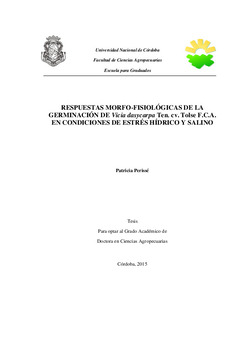| dc.contributor.advisor | Tourn, Graciela Mónica | |
| dc.contributor.author | Perissé, Patricia | |
| dc.date.accessioned | 2015-08-31T19:21:37Z | |
| dc.date.available | 2015-08-31T19:21:37Z | |
| dc.date.issued | 2015 | |
| dc.identifier.uri | http://hdl.handle.net/11086/1989 | |
| dc.description | Tesis (Doctor en Ciencias Agropecuarias)--UNC- Facultad de Ciencias Agropecuarias, 2015. | es |
| dc.description.abstract | El movimiento de ganado hacia zonas marginales en Argentina ha llevado a las especies
forrajeras a la heterogeneidad ambiental. Esto requiere del uso adecuado de las especies y
variedades en estos entornos. Vicia dasycarpa Ten. cv. Tolse F.C.A., se destaca como una
forrajera de ciclo otoño-invierno-primaveral que aporta materia seca de calidad. El objetivo
fue estudiar las respuestas morfo-fisiológicas de la germinación de V. dasycarpa Ten. cv.
Tolse F.C.A. en condiciones de estrés hídrico y salino. Se estudiaron las características
morfológicas de la semilla en relación con la zona de entrada de agua en la imbibición. Se
realizaron ensayos para establecer el porcentaje de germinación según los distintos
tratamientos: testigo 0 MPa; PEG -0,3; -0,6; -0,8; -1 y -1,2 MPa; ClNa -0,3; -0,6; -0,8; -1 y
-1,2 MPa. Se utilizó la metodología convencional para realizar los estudios exomorfológicos
y anatómicos -microscopía estereoscópica, óptica (MO) y de barrido (MEB)-, para la
ultraestructura -microscopía de transmisión (MET). Los resultados indican que la semilla
presenta el hilo lineal, el micrópilo deltoide adnato al hilo, la cubierta seminal marrón
rojiza oscura con vetas negras, y el patrón de ornamentación es papiloso. Se comprobó la
presencia de un capuchón radicular y se identificó la presencia de dos pares de aréolas
cotiledonares. La entrada de agua en la imbibición se inicia por la lente -con grietas- y
avanza en el plano sagital. La germinación es criptohipógea y la plántula presenta tres
catafilos fértiles (con yemas axilares desarrolladas). Bajo condiciones de estrés hídrico y
salino, con un potencial agua equivalente a -0,6 MPa, se superó el 80% de germinación.
Según el modelo de tiempo hídrico el potencial de base para el 50% de germinación fue de
-0,9 MPa para PEG y -1,4 MPa para ClNa. Los estudios morfo-fisiológicos demostraron
una disminución del crecimiento del sistema radical y caulinar en todos los tratamientos.
En el sistema caulinar, las yemas axilares desarrolladas son una estrategia para la
recuperación frente al estrés. La estructura anatómica de la raíz se vió afectada por el estrés
hídrico y salino. Se manifestó plasmólisis celular en la rizodermis y la corteza; en los
tratamientos más severos de estrés hídrico la endodermis se colapsó. V. dasycarpa cv.
Tolse FCA, puede considerarse una forrajera promisoria para su cultivo en suelos con
problemas de deficiencia hídrica o salinidad. | es |
| dc.description.abstract | The movement of livestock into marginal areas in Argentina has led the forage species to
environmental heterogeneity. This requires the proper use of species and varieties in these
environments. Vicia dasycarpa Ten. cv. Tolse F.C.A. stands out as forage of autumnwinter-
spring cycle that provides quality dry matter. The aim was to study the morphophysiological
responses of germinating V. dasycarpa Ten. cv. Tolse F.C.A. under water
and salt stress. The morphological characteristics of the seeds were studied in relation to
the area of imbibition water entry. Tests were conducted to determine the percentage of
germination under different treatments: control 0 MPa; PEG-0.3; -0.6; -0.8; -1 and -1.2
MPa; NaCl -0.3; -0.6; -0.8; -1 and -1.2 MPa. The conventional methodology was used to
perform the morphological and anatomical studies -stereoscopic microscopy, optical
microscopy (OM), scanning elect ron microscopy (SEM)- and for the ul t rast ructure
-transmission electron microscopy (TEM). The results indicate that the seed has a linear
hilum, a deltoid micropyle; the seed coat is dark reddish brown, with black streaks and the
pattern of ornamentation is papillose. It was confirmed the presence of a radicle pocket and
the presence of two pairs of cotyledonal areoles were identified. It was established that the
entry of water during imbibition starts at the lens -having cracks- and moves in the sagittal
plane. The germination is crypto-hypogeal and the seedling has three fertile cataphylls
(with its developed buds). Under conditions of water and salt stress, with a water potential
equivalent to -0.6 MPa, it was overcame the 80% germination. For the hydrotime model
the base water potential to reach the 50% germination was -0.9 MPa for PEG and -1.4 MPa
for ClNa. The morpho-physiological studies showed a decrease in growth of both the root
and caulinar system in all treatments. In the caulinar system the axillary buds developed
are a recovery strategy to stress. The anatomical structure of the root was affected by water
and salt stress. Cellular plasmolysis was manifested in the rhizodermis and cortex; in the
most severe water stress treatments endodermis collapsed. V. dasycarpa cv. Tolse F.C.A.
can be considered a promising forage for growing under soils with water deficiency or
salinity problems. | en |
| dc.format.extent | 102 h. : ilustración color | es |
| dc.language.iso | spa | es |
| dc.rights | Atribución-NoComercial-SinDerivadas 2.5 Argentina | * |
| dc.rights.uri | http://creativecommons.org/licenses/by-nc-nd/2.5/ar/ | * |
| dc.subject | Vicia | es |
| dc.subject | Respuesta de la planta | es |
| dc.subject | Respuesta fisiológica | es |
| dc.subject | Germinación | es |
| dc.subject | Semilla | es |
| dc.subject | Morfología | es |
| dc.subject | Estrés hídrico | es |
| dc.subject | Estrés osmótico | es |
| dc.title | Respuestas morfo-fisiológicas de la germinación de Vicia dasycarpa Ten. cv. Tolse F.C.A. en condiciones de estrés hídrico y salino | es |
| dc.type | doctoralThesis | es |





